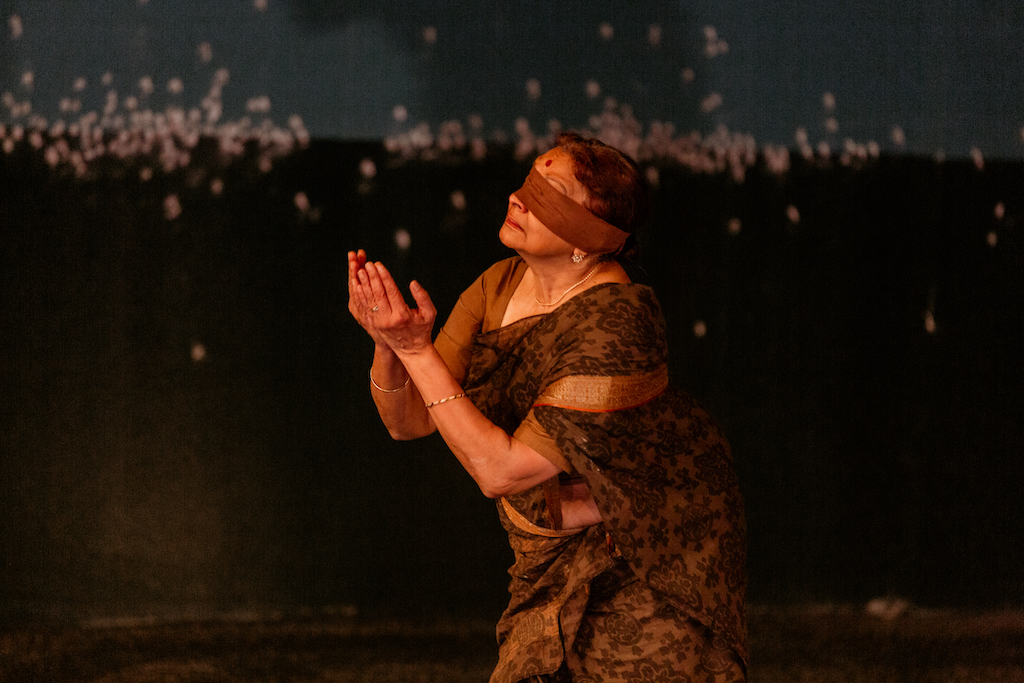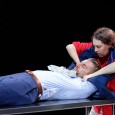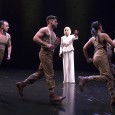Engrossing, sad, beautiful, heartbreaking. This wonderful story of a Sri Lankan family torn apart by civil war is brilliantly performed by its multi-national cast, several of whom were in the fabulous Belvoir/Co Curious collaboration Counting and Cracking, which proved such an enormous hit both in Australia, where it premiered, and overseas.
The opening scene of The Jungle and the Sea is mesmerising. Acclaimed Indian classical dance artist Anandavalli takes the stage. She is blindfolded; there is silence. And she begins to move with such slow, sorrowful grace and expression that no one can look away. Anandavalli is the mother figure in this play, a Tamil by the name of Gowrie, but she is all mothers in a script that draws on contemporary tragedy and also on stories in The Mahābhāratha and Antigone.
Gowrie’s dance ends and she retreats, her head turned from the audience. Another figure appears. ‘They have discovered the bodies,’ he announces.
We flashback to 1995. A raucous afterschool cricket match introduces Gowrie’s family: her three daughters, Madhu (Nadie Kammallweera), Lakshmi (Emma Harvie) and Abi (Kalieaswari Srinivasan), her son Alihan (Biman Wimalaratne) and their friend Himal (Rajan Velu). Gowrie tells her daughters they must study. They appeal to their father Siva (Prakash Belawadi) and concessions are made. Soon we know the ambitions and aspirations of these young people. War is bubbling in Sri Lanka – the majority Sinhalese fighting Tamils – but even in a war, life goes on in all its messy gloriousness.
But in war, bombs fall. And in civil war, families are split, and turn on each other, fight each other. In the name of… what? Humans are slow learners, as the news reminds us daily, and the futility of war is an underlying theme here, but there is much more.
To quote S. Shakthidharan, who, together with Belvoir’s Eamon Flack, is co-writer and co-director of The Jungle and the Sea, the play ‘celebrates how love, irreverence, hope, joy and determination continue to flourish, even in times of loss, in the most unlikely and wonderful of ways. And through this, we slowly chart a path to justice.
‘Counting and Cracking was written in honour of those who tried to halt Sri Lanka’s descent into civil war. The Jungle and the Sea is written in honour of those who survived [it], and the ways they found to uphold their dignity even when everything else was falling down around them.’
Gowrie wants little more than to keep her family close and together, but by the end of Act 1 fighting has forced her son from their village and into the Tigers army; her wounded husband and Lakshmi are en route to Australia; and she, Madhu, Abi and Himal (now married, despite their different religions, one Buddhist, one Hindu) are on the road, looking for Alihan and a safe refuge.
Years pass. In Sydney, Lakshmi graduates with a law degree and in one of the play’s humorous moments takes her reluctant father to dinner at Bennelong. It’s not just the small portions of food that Siva finds unpalatable – it’s his now Australian atheist daughter’s choice of partner.
Meanwhile, the war in Sri Lanka continues and the net is tightening for Tamils. Descriptions of carnage are delivered by Madhu to her blindfolded mother. A dead baby in a tree, its feet blown away. Bodies everywhere.
Lakshimi can bear it no longer. Armed with her knowledge of the law, she returns to her homeland in a bid to bring her family back to Australia.
By Act 3, peace has been declared. Which everyone wants to believe. But who is left, how to proceed now and how to honour the dead? Such questions open new rifts, cogent arguments and more dangers. The writing and the performances throughout The Jungle and the Sea are exceptionally strong, never more so in these final scenes. Kammallweera reappears as Devla, a wise woman from the jungle, who rains down prophesies on those who will not countenance compromise and peace. ‘These words are arrows,’ she declares at government official Kishan (one of several roles played by Jacob Rajun). ‘They are aimed at your heart.’
A fact: 50,000 went missing in the war, but the government does not declare them dead. As one character remarks: ‘The war will not be over in this country until everyone is dead.’ Another asks, earlier in the piece: ‘Can many things be true at once?’ And order, questions another, is that not also ‘a form of violence, of control?’.
The Jungle and the Sea runs for three hours (with two intervals) and at a cracking pace. The time flies past, unlike the events in the play which span 25 years. The subject matter is often dark but the dialogue is light, and not without humour. The cast of ten includes two superb musicians, integral to the rich and layered atmosphere created: Indu Balachandran, on a stringed instrument called a veena, and vocalist Arjunan Puveendran, who also plays the percussive mridangam.
Much use is made of the revolve, which in itself could be a read as the spinning chaos engendered by war and relocation and giddy hope. A wheel of fortune or disaster. Dale Ferguson’s set design is bare yet evocative: grey-blue and teal walls, with a horizon that could be peppered with bullet holes – or stars. Playful touches – so typical of Belvoir productions – include toy trucks and planes, a model of the Harbour Bridge, to signify travel and location.
The Jungle and the Sea is an epic story and, like its companion piece Counting and Cracking, is not to be missed. There is so much to commend. It is likely to sell out quickly, so get in quick.
At Belvoir St Theatre until 18th December.
Tickets from $30 to $70. https://belvoir.com.au/productions/the-jungle-and-the-sea-2/ or (02) 9699 3444





